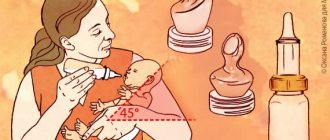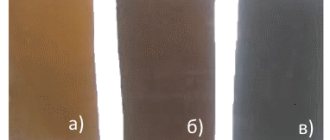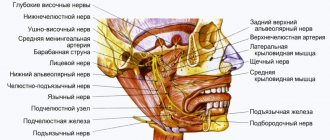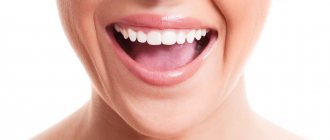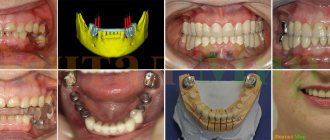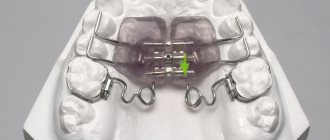Rozhkov I.A. Dental units “ANTOS” - a new model range of the “A” series are already in Russia!
Problems of “Clinical Gnathology”
Gnathology is the science of the interaction of all organs of the dentofacial system, including anatomy, physiology, and pathophysiology of this system, involving a comprehensive study, diagnosis and planning of treatment measures.
"Clinical Gnathology" implies an emphasis on the practical use of this science.
Over the past 20 years, there has been a technological breakthrough in domestic dentistry: new materials have appeared, and modern, high-quality, aesthetically pleasing dentures have begun to be used. Why is the number of patient complaints about dental care increasing and currently, according to forensic data, is one of the first places among complaints brought against doctors of various specialties?
We believe that one of the reasons for this situation is insufficient attention to the problems of Gnathology.
Based on clinical observations, back in the 80s we described numerous dental and neurological symptoms that arise as a result of diagnostic and treatment errors. The first works were published on the problems of “Clinical Gnathology”, on electromyography of masticatory muscles in normal and pathological conditions, on phonography and tomography (and later computed tomography) of the temporomandibular joint. Our use of intra- and extraoral recording of movements of the lower jaw improved the diagnosis of functional disorders and made it possible to imagine their pathogenesis.
For the diagnosis and design of dentures, we first mastered and used articulators in practice (1982-1983).
Unfortunately, in those years, new developments had difficulty making their way into practice. This was also facilitated by the fact that there was no Gnathology in dental training programs at universities. Textbooks still contain long-outdated materials on “Biomechanics of the masticatory apparatus.” There is no special textbook on “Clinical Gnathology”.
The domestic industry does not produce instruments and devices for studying the function of the dentofacial system or simulating the movements of the lower jaw.
In Europe and throughout the world, much attention is paid to the development of Gnathology. Dental companies produce numerous devices and articulators. All countries have books and teaching aids on this topic. Many educational institutions abroad have programs in Gnathology, designed for several years of study. They are implemented throughout the entire learning process or in special courses and departments.
Advanced courses in Gnathology are available in many European Universities. The best of them are considered to be the courses taught by professors A.Gutowski (Germany) and R.SIavicek (Austria).
At international exhibitions (Cologne) a variety of pantographs (mechanical and electronic), articulators of all types and for various purposes are constantly demonstrated.
Knowledge of “Clinical Gnathology” is necessary for a dentist of any profile:
— to assess occlusion in normal and pathological conditions;
— for the diagnosis and treatment of muscular-articular dysfunction, diseases of the temporomandibular joint, facial pain;
— to create stable central occlusion for all types of occlusal correction (orthopedic, orthodontic, orthognathic surgery);
— for planning functional occlusion in the manufacture of orthopedic structures;
— to assess the effect of occlusal trauma on the periodontium;
— for repositioning jaw fragments in accordance with correct occlusion;
— to determine the location and direction of the implant;
— when choosing a treatment method and determining a plan for medical interventions;
- to evaluate records of movements of the lower jaw and compare these records with other indicators of the functional analysis of the dentofacial system.
Several years ago, on the initiative of StAR, an educational and advisory and “Professor's Author's” clinic was organized, where we compiled a program for advanced training of doctors and dental technicians in “Clinical Gnathology” (headed by V.D. Wagner).
Classes at the organized training center aroused great interest among dentists. Doctors from many private clinics and offices, university teachers repeatedly attend these classes and use the acquired knowledge in practice.
We associate the further development of “Clinical Gnathology” with publications in the corresponding section of the “Maestro” magazine, as well as with the planned organization of the “Clinical Gnathology” section under the auspices of StAR. It is necessary to create “Clinical Gnathology” departments in universities and advanced training faculties for doctors.
An important matter is the introduction into the curriculum of dental departments and schools of the basics of “Clinical Gnathology”, a section on the peculiarities of working with articulators, on new methods of modeling the occlusal surface, setting teeth, etc.
In Russia and the CIS countries there are only a few specialists on this problem, and they interpret the same concepts and treatment methods differently, sometimes they do not have basic knowledge of Gnathology, patients receive conflicting advisory opinions, which is often the source of iatrogenic diseases.
Standards are required for “Clinical Gnathology” as a general dental discipline (such disciplines include, for example, anesthesiology, dental neurology, medical psychology, etc.). This means that a specialist dealing with the problems of “Clinical Gnathology” must have:
— dental unit, office;
— necessary equipment (face bows, articulator, pantograph, funciograph, etc.), materials (gypsum No. 3,4, special wax, molds for casting models), etc.;
— experience working with patients with occlusion disorders, temporomandibular joint disorders, bruxism, facial pain;
— document confirming completion of courses in Clinical Gnathology.
It is also advisable to create courses on “Clinical Gnathology”, for example, at the departments of general dental practice, where classes could be conducted with students, as well as train teachers in this discipline (personnel for personnel).
I urge the public to take part in creating a scenario for the formation of “Clinical Gnathology” as a general dental discipline.
Best regards, Prof. V.A. Khvatova
Clinical gnathology
Gnathology refers to a dental field located at the intersection of dentistry and maxillofacial surgery. This dental discipline studies the subtle relationships of all organs and tissues of the dental system. Gnathology combines knowledge about:
- teeth;
- dentition;
- temporomandibular joint;
- condition of the masticatory muscles;
- biomechanics of chewing;
- periodontitis;
- the relationship between the proportions of the face and teeth.
In the absence of basic knowledge of gnathology, the doctor will not be able to competently and without serious “blunders” treat many dental pathologies - correct the bite, make a prosthesis, or carry out a surgical operation without complications.
For the correct and uninterrupted functioning of the temporomandibular joint, all chewing functions of the teeth and muscles responsible for the functioning of the lower jaw must be perfectly coordinated. Each link in the operation of the dental system is equally important, and the failure of one link of this system immediately disrupts the work of all other links.
Knowledge of gnathology is necessary even when filling teeth. In this case, the specialist restores the damaged area using materials that can give the desired shape to the tooth, taking into account the bite.
What is the temporomandibular joint, and how is it related to the functioning of our dental system?
The temporomandibular joint, or TMJ for short, is a two-part joint that attaches the lower jaw to the bones of the skull. It is responsible for the proper functioning of the lower jaw, for the processes of opening and closing the mouth and chewing food. Any changes in the joint lead to toothaches and discomfort in the neck and back of the head, as well as clicking in the joint, tinnitus and other symptoms.
Incorrect functioning of the TMJ is associated not only with bad childhood habits, but also with numerous unnerving situations. Due to frequent stress, the masticatory muscles are in constant tension. As a result, teeth can wear out or become loose, the articular head is displaced, the neurovascular bundle is pinched, severe pain occurs, and the person cannot chew food normally. We are so immersed in our problems that we don’t even notice how we constantly clench our teeth and learn about this bad habit only in a specialist’s office.
What treatment does a gnathologist prescribe?
The treatment tactics determined by the gnathologist depend on the clinical picture. If the patient shows signs of an acute condition, drug therapy is selected, including the use of painkillers that eliminate pain symptoms.
In the treatment of gnathological disorders, special therapeutic and diagnostic devices are widely used:
- To quickly eliminate occlusal disorders and pain syndrome, relaxation bite plates are used.
- For bruxism and decreased interalveolar height - disconnecting splints.
- To stabilize the position of the lower jaw after normalizing muscle tone, stabilizing splints are installed.
- To relieve pain and discomfort in the parotid-masticatory area without structural changes in the occlusion, centering splints are indicated.
- Mouthguards and trainers are used to relieve tension and restore muscle function.
To eliminate pathological dental occlusion, selective grinding of teeth is performed. And in order to correct and form the correct bite, a special treatment program is prescribed - myogymnastics, which allows you to restore proper muscle function.
When is it necessary to contact a gnathologist?
There is no need to constantly visit a gnathologist. The attending dentist can refer you to such a specialist if he has identified some problems with the condition of the dentofacial apparatus.
Consultation with a gnathologist-dentist may be required before orthodontic and orthopedic dental treatment.
What indications does clinical gnathology have:
- dysfunction of the temporomandibular joint;
- osteoarthritis, TMJ osteoarthritis;
- incomplete closure of the dentition;
- the appearance of dental anomalies;
- anatomically incorrect position of the jaws;
- numerous cracks in tooth enamel;
- pain in the jaw and neck area of unknown etiology;
- grinding of teeth (bruxism).
What is gnathology?
The human dental system consists of the jaw bones, muscles, ligaments, teeth, tongue, temporomandibular joint (TMJ) and nerves. The work of all these organs, as well as their interaction with each other and with the body as a whole, is studied by gnathology. The proper functioning of our chewing system depends on the condition of the spine, on posture, on how a person breathes, and on many bad habits we have acquired. And, conversely, a downward influence is also possible: problems in the temporomandibular joint can result, for example, in pain in the legs.
Restorative dentistry has made amazing strides in recent years. Dentists - orthopedists, orthodontists, and estheticians have learned to literally recreate amazingly beautiful smiles that can change a person’s life. However, if during treatment the doctor does not take into account the myofunctional disorders the patient has, then the result of the work will not bring satisfaction to any of them. It is possible to achieve high aesthetics and improve the functioning of the dentofacial apparatus only if we consider each restored tooth not as a separate unit, but as an integral part of the whole organism.
Gnathology is closely related to such relatively new specialties as osteopathy, kinesiology, as well as neurology and otolaryngology. Dental gnathologists work closely with these specialists.
How can you understand that pain and spasms in the jaw area are associated specifically with the TMJ?
Most often, with disorders of the TMJ, people go to the dentist with complaints of toothache. And only an experienced dentist can determine that this patient needs to undergo a full examination by a gnathologist.
When diagnosing disorders in the functioning of the TMJ and the dental system as a whole, a number of devices are used that evaluate the functioning of the muscles and joints, determine exactly how the teeth close, and help relieve spasms. The patient must be examined using all of the above equipment in order to identify and eliminate the cause of anomalies that have arisen in this area.
Muscles involved in chewing
The function of the masticatory muscles is very complex and diverse; they are responsible for the position and movement of the lower jaw. The muscles of the neck and pharynx are also involved in this process - they are the ones that move the lower jaw back and return it forward.
- Chewing muscle. Its main function is to move the lower jaw upward. Additionally, she can move the jaw forward and towards the contracted muscle.
EMG activity can be noted during forward-backward and sideways movement.
The muscle itself is rectangular and consists of 2 main parts - superficial and deep. The superficial one is attached to the lower part of the zygomatic arch, and the deep one to the inner part of the zygomatic arch, after which they together reach the outer surface and the angle of the lower jaw.
- Temporalis muscle. It is also responsible for moving the lower jaw upward and, in addition, also backward.
This muscle is responsible more for the coordination of movements, and not for their strength. The temporalis muscle is attached to the temporal cavity and reaches the coronoid process of the mandible.
- Medial pterygoid muscle. At one end, this muscle is attached to the fossa of the pterygoid process of the main bone and reaches the angle of the lower jaw. Its main function is to move the lower jaw upward, forward and sideways with unilateral contraction.
- Lateral pterygoid muscle. It is responsible for moving the lower jaw forward, and with unilateral contraction, to the side. It consists of 2 parts: the upper part starts from the wing of the sphenoid bone, and the lower part from the pterygoid process of the lower jaw, after which the upper part ends on the capsule of the joint of the lower jaw, and the lower part to the pterygoid fossa of the articular process of the lower jaw. This muscle is of great importance for the correct positioning of the articular head and disc relative to the articular bed.
- Also, much attention should be paid to the group of muscles responsible for lowering the lower jaw. These include the mylohyoid, geniohyoid, digastric, hypoglossus and genioglossus muscles. The muscles that lower the lower jaw are responsible for its downward and posterior movements.
When the lower jaw moves, a uniform and consistent contraction of some muscles and passive stretching of others occurs, after which they change places so that the lower jaw returns to its original position.
